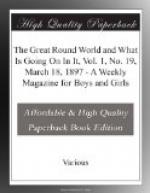(Postage on single maps, 5 cents.)
* * * * *
“I would advise =Sunday-school teachers= to use, in connection with the lessons of 1897, =Klemm’s Relief Map of the Roman Empire=. Every scholar who can draw should have a copy of it. Being blank, it can be beautifully colored: waters, blue; mountains, brown; valleys, green; deserts, yellow; cities marked with pin-holes; and the journeys of Paul can be traced upon it.”—Mrs. Wilbur F. Crafts, President International Union of Primary Sabbath-School Teachers of the United States.
* * * * *
=Description of the maps.=
These maps are made in two forms, both with beautifully executed relief (embossed)—the cheaper ones of plain stiff paper similar to drawing paper (these are to be substituted for and used as outline map blanks), the others covered with a durable waterproof surface, that can be quickly cleaned with a damp sponge, adapted to receive a succession of markings and cleansings. Oceans, lakes, and rivers, as well as land, appear in the same color, white, so as to facilitate the use of the map as a =_geographical slate_=.
* * * * *
=William Beverley
Harison
3 & 5 W. 18th St. ...
New York City=
* * * * *
=Evolution of Empire Series=
UNITED STATES
BY
MARY PLATT PARMELE
AUTHOR OF
="Who? When? What?” “France,” “Germany,” “England,” Etc.=
Price,
Post-paid
75 Cents
* * * * *
From New York Sun Editorial Dec. 30, 1896.
In too many of the little school histories there is but a tedious, bare narrative of apparently unconnected facts, and there is a profitless rigmarole of dates and names: but when the sequence of cause and effect is not obscured, and form and life are given to the actors, and the development of events and institutions is traced, the story of the United States becomes, as it should become, the most, fascinating as it is the most important of histories to Americans; and whatever in historical inquiry and writing promotes accuracy, adds detail, and clears up obscurity, increases the worth and the, charm of the work.
W.B. Harison has published in his “Evolution of Empire” series, a brief historical sketch of the United States, by Mary Platt Parmele, whose other volumes in the series have received cordial praise. In this book one finds the story of our country told in about 300 pages, and very interestingly is it written. The book leaves out the innumerable incidents and figures which are of great importance to students, but which are not necessary in a book for general reading, and presents the narrative in a graphic manner, in which the interest of the reader never flags. The book is bound in blue buckram and costs but 75 cents. The other volumes in the series deal with the histories of France, England, and Germany, in the same brilliant vein.—Hartford Post.




